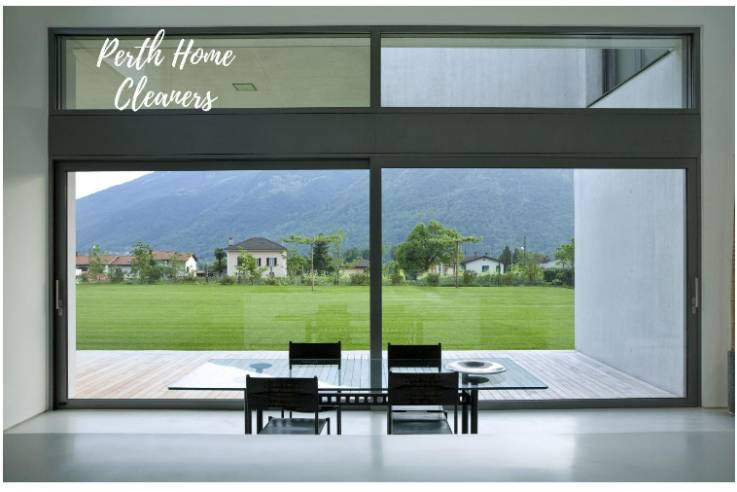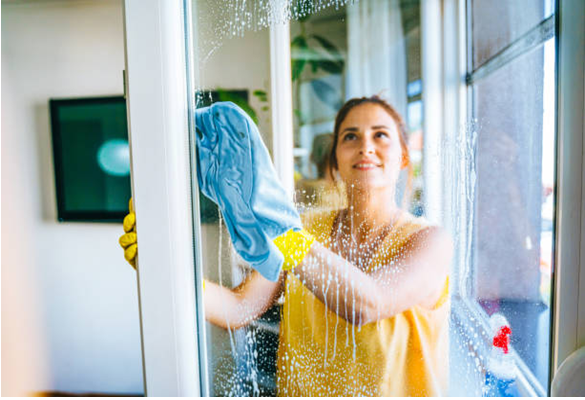How To Clean Windows Like A Pro
Windows are the mirrors of our house. These are the things that add class to our house and reflect its beauty. They are the gateway through which light enters our houses.
They make a big difference in the overall ambiance of our environment.
The best thing about cleaning windows is that you can do it yourself without help from anyone else. However, if this is your first time doing it, it might be a little difficult at first, but once you get the hang of it, there is nothing more satisfying than cleaning your window panes!
So, if you want to know how to clean windows like a pro, then keep reading this article, as we will tell you everything you need to know about cleaning window panes like an expert!

Importance Of Clean Windows
Clean windows are important for several reasons:
- Aesthetically pleasing: clean windows give a sense of cleanliness and tidiness to a home or business. They allow natural light to come in and make a space look more inviting.
- Health: Dirty windows can harbour bacteria and allergens, which can harm people with allergies or respiratory issues. Clean windows help to reduce these health risks.
- Energy efficiency: Windows covered in dirt and grime will not allow as much natural light to come in, which can lead to higher energy costs as people rely more on artificial lighting. Clean windows allow more light to come in, thus reducing energy usage and costs.
- Durability: Over time, dirt and grime can scratch the glass and damage the window. Regular cleaning helps protect them and extend their lifespan.
- Safety: Dirty windows can obstruct visibility, which can be a safety hazard while driving or walking. Clean windows ensure that people have a clear view of their surroundings.
Tools And Materials Needed For The Job

Most people don’t like cleaning windows, but it’s very important. You wouldn’t eat a meal with dirty dishes, would you?
So why would you let your windows collect dust or smudge when there are so many easy ways to clean them? Many products on the market can help you keep your windows sparkling clean, you will need one or more of these to get the job done.
- Window cleaner (we recommend Windex window cleaner)
- Soft scrubber or sponge
- Window cleaning brush
- A piece of cloth (microfiber)
- Paper towels to dry the window
- A vacuum cleaner with a crevice tool attachment
- Rubber gloves (to protect your hands)
- Old toothbrush (for hard-to-reach places)
- A squeegee with a long handle
- Bucket with warm water
Preparing For The Job

Before starting the cleaning process, it is important to set up and prepare for the job properly. This process may include:
- Setting up ladders and poles
First, ensure you have a stable ladder that is tall enough to reach the highest windows you need to clean. Place the ladder on a flat, stable surface, and make sure the feet are fully extended and locked. If you’re using a ladder that requires leaning against a wall, make sure the wall is sturdy and secure.Next, set up your poles. If you’re using a traditional window cleaning pole, ensure that it’s fully extended and locked in place. If you’re using a telescoping pole, make sure it’s fully extended and fixed in place.Before climbing the ladder or using the poles, ensure you have all the necessary cleaning supplies within reach. That includes window cleaning solutions, rags, sponges, and any other tools you may need.
By properly setting up your ladders and poles, you’ll be able to safely and efficiently clean your windows like a pro.
- Protecting the surrounding area (furniture, plants, etc.)
Before cleaning your windows, it’s important to protect the surrounding area. You may have to cover your furniture, plants, and any other items that can get in the way. Some things might even get dirty during the cleaning process.To protect your furniture, you can use old blankets, sheets, or towels to cover them. Ensure the covers are secure so they won’t slip or fall off.If you have plants in the room, you can either move them to another room or cover them with a plastic sheet or garbage bag. It will protect them from any cleaning solutions that may accidentally spill.
Removing Cobwebs

To remove cobwebs, you will need a ladder or stepladder, a soft-bristled broom or dust brush, and a vacuum cleaner.
Climb the ladder and use the broom or dust brush to sweep away any cobwebs gently. Be careful not to scratch the glass.
Once you have removed as much as you can with the broom or brush, use the vacuum cleaner to suck up any remaining debris.
Cleaning Lower-Level Windows

- Gather your supplies: a bucket, a squeegee, a scrubber or sponge, and a window cleaning solution.
- Remove any debris or cobwebs from the window frame and sill.
- Fill your bucket with warm water and a few squirts of the window cleaning solution.
- Dip your scrubber or sponge into the solution and scrub the window. Start from the top and work your way down. Make sure to get all the corners and edges.
- Rinse the window with a bucket of clean water.
- Wipe the window dry with a cloth or paper towel.
- Use the squeegee to remove any excess water and streaks from the window. Start at the top and pull the squeegee down in a straight line. Wipe the blade with a clean cloth after each pass.
- Repeat the process on the other side of the window.
- Wipe down the window frame and sill with a clean, dry cloth to remove any remaining dirt or solution.
Cleaning Higher Level Windows

- Gather your supplies: a bucket, a scrubber or sponge, a window cleaning solution, a ladder, and a long-handled squeegee or window cleaning brush.
- Remove any debris or cobwebs from the window frame and sill.
- Fill your bucket with warm water and a few squirts of the window cleaning solution.
- Use the ladder to reach the upper-level window safely.
- Dip your scrubber or sponge into the solution and scrub the window, start from the top and work your way down. Make sure to get all corners and edges.
- Rinse the window with a bucket of clean water.
- Wipe the window dry with a cloth or paper towel.
- Use the long-handled squeegee or window cleaning brush to remove any excess water and streaks from the window. Start at the top and pull the squeegee or brush down in a straight line. Wipe the blade or brush with a clean cloth after each pass.
- Repeat the process on the other side of the window.
- Wipe down the window frame and sill with a clean, dry cloth to remove any remaining dirt or solution.
Flyscreens And Frames

- Start by removing the flyscreens from the window frames. To do this, lift the screen up and out of the frame.
- Once the flyscreen is removed, use a sponge to wipe down the frames gently. If dirt or grime is stuck on the frames, apply the cleaning solution and water to help loosen them.
- Once the frames are clean, it’s time to move on to the flyscreens. Begin by shaking the screens to remove any loose dirt or debris.
- Next, use a sponge to wipe down the screens gently. If the screens are particularly dirty, you may need to apply the cleaning solution and warm water to help loosen the dirt.
- Once you have cleaned both the frames and the screens, allow them to dry completely before reattaching the screens to the frames.
- To ensure a thorough cleaning, you may want to repeat this process every few months, especially if you live in an area with high levels of dust or pollution.
Tips For Cleaning Hard-To-Reach Areas

- Start by using the vacuum cleaner with the crevice tool attachment to remove any loose dirt or debris from the hard-to-reach areas of the windows. This will help loosen any stuck-on dirt and make cleaning easier.
- Once you have vacuumed the area, use an old toothbrush to scrub away any remaining dirt or grime. The toothbrush’s bristles are perfect for getting into tight spaces and removing stubborn dirt.
- If the dirt is particularly hard to remove, you may need a window cleaner or mild soap solution to help break it up. Simply mix a small amount of cleaner or soap with water and apply it to the area with a clean cloth or sponge.
- Once you have cleaned the hard-to-reach areas, use a clean, dry cloth to wipe away any excess cleaner or water. This will help prevent streaks and ensure that your windows look crystal clear.
- Repeat this process as needed to ensure that all the hard-to-reach areas of your windows are clean and sparkling. Remember also to clean the edges of the windows and any other areas that are difficult to reach, such as corners or crevices.
The Finishing Touches

After completing the steps above, it’s important to finish your window cleaning with a few final touches to ensure that your windows are sparkling and streak-free. Here are a few things you can do:
- Use a microfiber cloth or squeegee to remove any water or streaks. Make sure to go over the edges and get rid of any water that may have dripped down.
- Dry the windowsills with a cloth or towel to remove any moisture.
- If you have any hard water stains or streaks, use vinegar and water to scrub them away.
- If you’re still noticing streaks or smudges, use a window cleaning solution specifically to remove them.
- If you’re working outside, use a leaf blower or small broom to remove debris or cobwebs from the window frames and sills.
By following these steps, you can be confident that your windows will be sparkling clean and look like a pro did the job!
Using A Pure Water System For Window Cleaning

Pure water systems use purified water stripped of all impurities, and it’s perfect for leaving a crystal clear, streak-free finish on your windows.
Benefits of using a pure water system:
- Improved cleaning results: Pure water has a high surface tension, allowing it to cling to surfaces and dissolve dirt, grime, and stains more effectively than tap water. This results in a streak-free, crystal-clear finish on windows.
- Eco-friendly: Pure water systems do not use chemicals or detergents; they are more environmentally friendly and safe for the user.
- Increased efficiency: A pure water system allows you to clean windows faster as it requires less elbow grease and time to dry.
- Safe to use: Pure water systems are safe on all types of windows, including tinted and coated ones, as they do not contain any harsh chemicals that could damage the glass’s surface.
- Reduced need for chemicals: Using a pure water system reduces the need for chemical cleaners, which can harm the environment and the user.
How to use a pure water system for window cleaning:
- Fill the pure water system with de-ionized water.
- Attach the hose and spray gun to the system.
- Spray pure water onto the window surface, starting at the top and working your way down.
- Wipe the window with a microfiber cloth or squeegee to remove the dirt and grime.
- Dry the window with a clean microfiber cloth or leave it to air dry.
- Repeat the process on the other side of the window if necessary.
- Disconnect the hose and spray gun from the pure water system and store it away responsibly for future use.
Protecting And Maintaining The Window
After the window is completely dry, you should consider applying a window sealant or a protectant that helps repel water and dirt in the future.
Regularly dust and vacuum the window frame and sill to prevent the build-up of dirt and debris.
If you notice any cracks or chips in the window, have them repaired as soon as possible to prevent further damage.
Make a cleaning schedule, such as once a week or once a month, to maintain a clean and clear view.
Wrap Up
In conclusion, cleaning windows like a pro involves a combination of the right tools, proper technique, and attention to detail. Following the steps outlined above, you can enjoy sparkling, streak-free windows too. Gather all necessary materials, such as a squeegee, microfiber cloths, and a window cleaning solution.
Next, follow a systematic approach to clean the windows and start at the top while slowly working your way down. Be sure to use the squeegee in a back-and-forth motion, and wipe away any excess solution with a microfiber cloth.
Finally, remember to clean the frames and edges of the window to ensure a thorough, professional-grade cleaning job. With a little practice and dedication, you can master the art of window cleaning and impress your friends and family with your own sparkling windows.
For more information regarding window cleaning, check out the International Window Cleaning Association (IWCA) website. They have a wealth of knowledge and resources on the best techniques and tools needed for streak-free windows.








